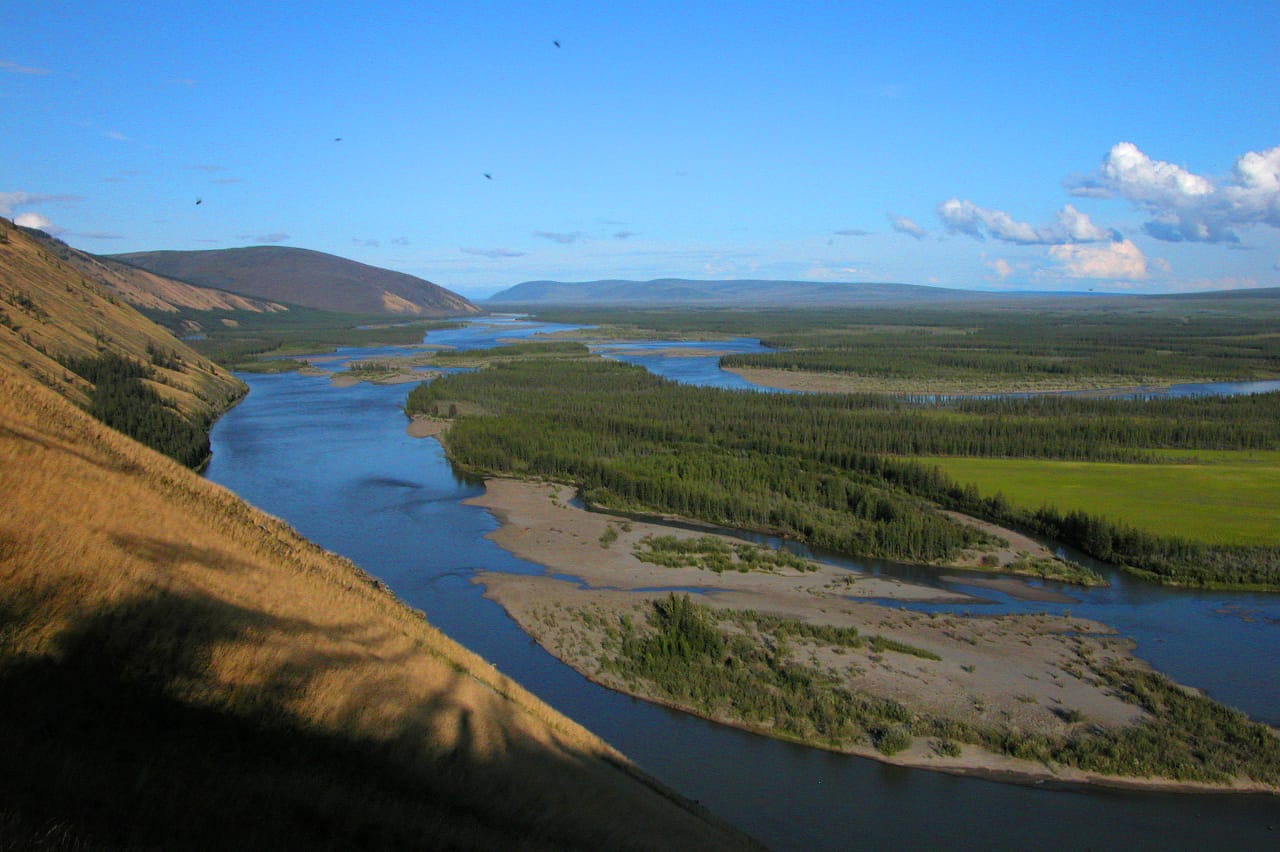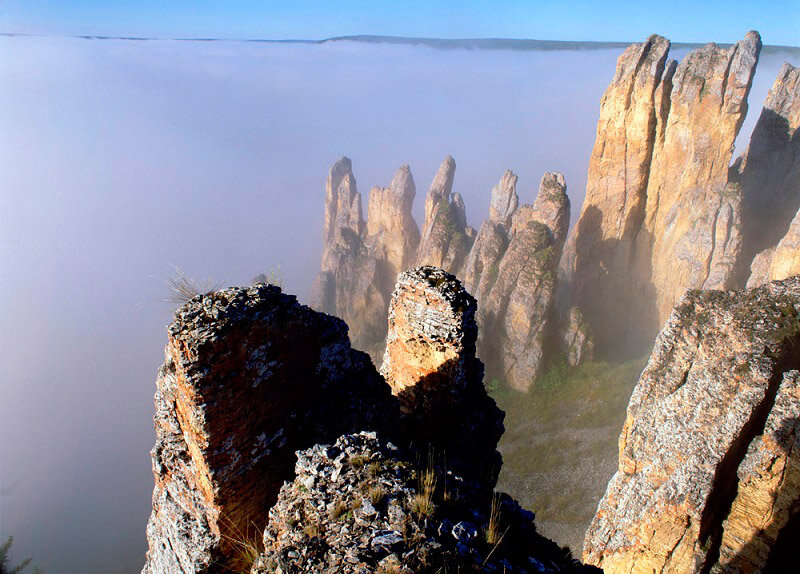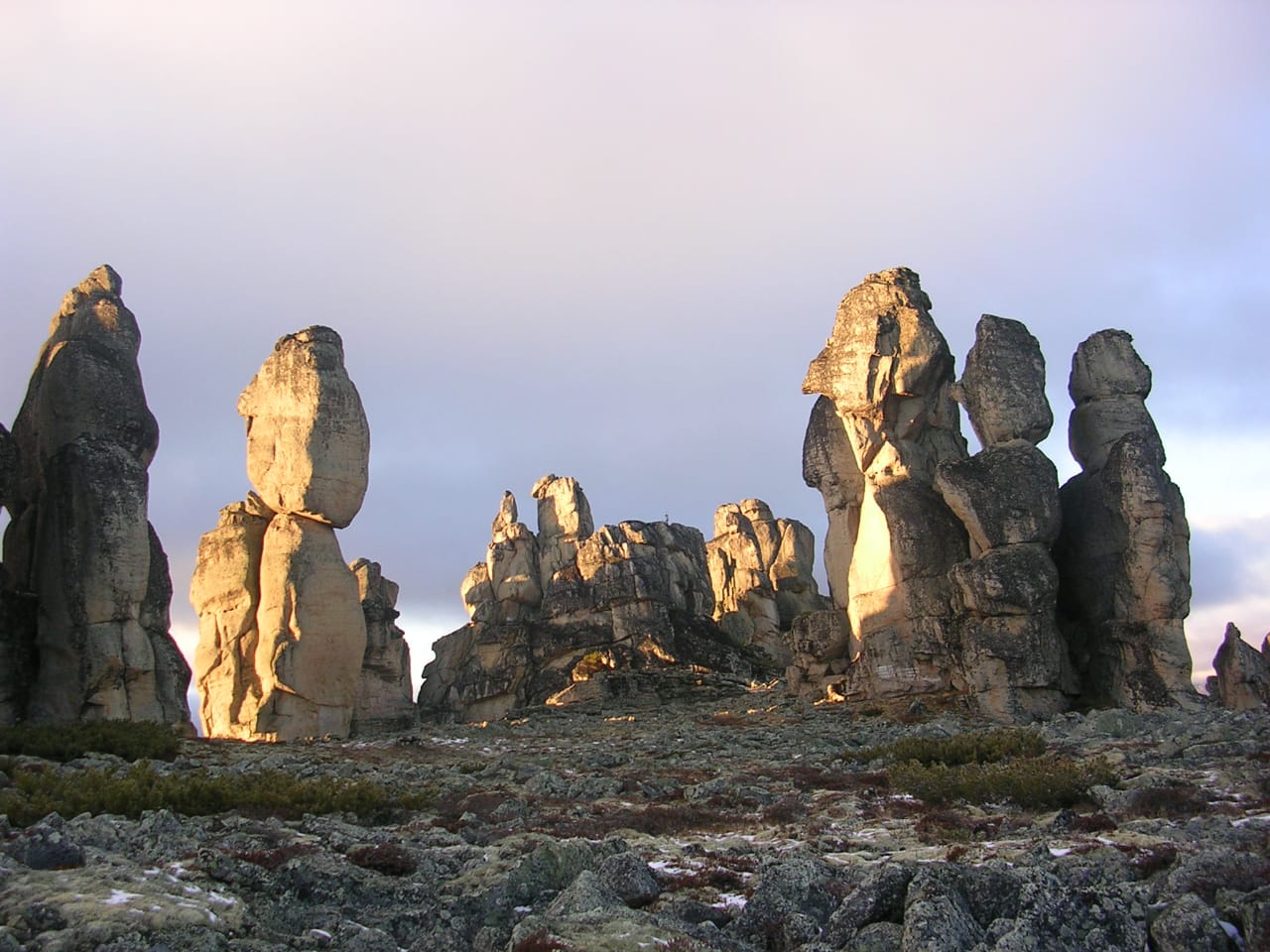
Vladimir Chirikov is the Director General of LLC Arktika, he initiated the tourism project and launched the ‘Sacred Kisilyakh Mount - Northern Shambhala’ regional brand. He has graduated from the Novosibirsk State University, the Geological and Geophysical Department. He descends from a distinguished merchant family and in the 1990s, he entered the business market. He carries on business, including tourism, and gives back to the community.
- One of the most mysterious and beautiful places in Yakutia is undoubtedly the Kisilyakh Mount. Where did the name ‘Northern Shambhala’ come from and why are the mountains considered sacred?
- The nature of Yakutia is amazing and mysterious. The Kisilyakh Mount (Yakut: Киhилээх) widely and quickly achieved fame as the ‘Energy Centre of the Planet’ and the ‘Northern Shambhala’, with its cliffs looking like human statues located on the watershed of the Yana and Adycha rivers, in the remote areas rather far away from civilization.

The word ‘kisi’ (Yakut: киhи) means a ‘human’, that is, the name of the mountain means the ‘Stone people’. There is a belief that during any disaster, the ancient Yakuts and the Evenkis who lived near the mountains turned to the supreme forces (the higher holy spirits of Aiyy (Yakut: Айыы) who lived on the Kisilyakh Mount. Only shamans and shaman assistants in shamanistic rituals, ‘kuturuksuts’ (Yakut: кутуруксут), were allowed to go up this mountain. According to the legends, the Kisilyakh Mount was the Gods’ Mountain. As for simple mortals living here, there was a taboo against going up this mount, or even looking at the sacred mountain for a long time. But at the same time, it was believed that a person who has been in this mountains with good intentions is charged with fresh extraterrestrial energy and is cleansed of dirty earthly energy and wickedness. So, the name ‘Northern Shambhala’ is given not by chance: it is the place of happiness, the ‘Energy Centre of the Planet’. Here, you can make a wish that will come true. And here come various people who want to be cured of illnesses, to change their pace of living.
- What is true in these legends associated with these places, but what is said just to attract the tourists?
- You know, there is a superstitious belief: the mountain retaliated against those who behaved ill in the sacred mountain (got drunk, shot, made noise) - there are many evidences.
As for recharging with energy - it's true. There is a supposal that these unique cliffs are the structures created to connect with the space, with civilizations that disappeared during the ‘Flood’. Perhaps, it is here that one should look for traces of the hypothetical ancient mainland ‘Arctida’ (Hyperbore) and the highly developed civilization of the Hyperboreans living on it, which is located in the far north, ‘beyond the north wind Boreas ...’, as described by Pliny the Elder. The search for the Hyperbore is akin to the search for the lost Atlantean continent, with the difference that the sunken Hyperbore still has a part of the land - the northern part of present-day Russia, probably, the Kisilyakh Mount. And this is not just about the traces of one of the ancient peoples, but about a powerful civilization, perhaps - as Valery Dyomin (the head of the ‘Hyperbore’ expedition) believed - the original homeland of the Aryan, Slavic peoples. Mysterious rafts, possibly, made by antediluvian people remained in the areas near Verkhoyansk and Oymyakon. These stone figures, up to 30-35 metres high, of the most bizarre shapes and unexpected compositions, carved from the hardest granite, are similar to the creations by the mysterious great forces.

- Well, then it's more like northern Stonehenge. Do you feel this magic effect?
- You know, the mountain, in its pristine and mysterious nature, really has a revitalizing effect. After a four-hour climbing to the mountain, a person who reached the top feels no fatigue and falls into euphoria. They say, the Kihilyah Mount is an energy amplifier, so you need to go there only with good thoughts.
Many tourists - after visiting the Kisilyakh Mount - change their pace of living and lifestyle, become more active, and shift to a healthy style of living; some resolve problems they could not settle earlier, some improve their health. The mountain has a sacred spring, which is considered medicinal - many bathe in it to rejuvenate and cleanse of dirty energy and wickedness.
I believe that the higher holy spirits of Aiyy descend to this mountain and that the rocks are charged with energy - there are hot rocks, although they should not be warm according to the laws of physics and geology. Everyone knows that the mountain is happy to meet those who are for the good, and punishes those who disturbed its peace ... It is also true that you do not fell hungry while you are in this mountain, that the batteries recharge, that a special state of mind appears - unearthly bliss and joy. It happens sometimes that the stones move and disappear. And the mountain burns pink in complete darkness.

- We have talked about mysticism. And how long ago was this sanctuary included in the register of specially protected natural reservations (SPNR) of the republic? What do the terms ‘resource reserve’ and ‘reserved areas (for natural monuments)’ mean?
- The concept of the specially protected natural reservations was introduced by Mikhail Nikolaev, the first president of Yakutia. The Tuostaah (Yakut: Туостаах) River flowing under the Kisilyakh Mount is a resource reserve - it is forbidden to fish there. The Kisilyakh and the Tuostaah are included in the SPNR, which are protected by ecologists. But tourism is allowed here.
- Will the development of tourism harm the ecological state of these places? After all, there are rare Red Book plants and animals here...
- People, civilized tourists, do no harm to the ecology of the area. The mountain is affected only by natural disasters - fires, for example. Last summer there was a terrible fire around this mountain.
- The Tuostaah mountain river is a great world of pristine, unspoilt nature, with its unique flora and fauna?
- The river valley is another mysterious place. There are colorful river pebbles and boulders under the powerful current. On the banks of the river, slender poplars grow, the pride and beauty of the Tuostaah area. And there, among the larch and poplar forest, we have built our modern Tuostaah Tourist Centre.
The Adycha and Tabalah people living in the Tuostaah area are traditional hunters. Even from old hunters, we heard about some springs with the Water of Life - these are geothermal springs that protect exotic plants from cold and create a stable microclimate. Winter temperature here is 15 and more degrees Celcium higher than in other places. In winter, nonfreezing water areas are often found in the Tuostaah River. When we, the geologists, did exploration of gold placers in those places in the 1990s, we were surprised that the valley of the gold-bearing stream froze only to a depth of 50-70 cm, and deeper, there were thaw zones fed by the internal mantle water. And there are very beautiful and varied landscapes - lakes, alpine belt, tundra ... In this ‘Polar Riviera’, poplars and larch trees are giant - up to 2.5 metres in girth and 30-40 metres high, and dense rowan thickets up to 7-10 metres high. The pristine wilderness, the diversity of flora and fauna were preserved there. In 1997, the Tuostaah Resource Reserve was established. 215 species of higher plants were identified here, 68 species of which are medicinal herbs allowed for use by scientific medicine, and four species were listed in the Red Book of Yakutia. The bird fauna and the resource reserve includes 148 species, which makes half the ornithofauna of Yakutia. 16 species of them are classified as rare endangered animals listed in the Red Book of Yakutia, 8 species of which are in the Red Book of Russia.
The following plants are of the most interest: as for medicinal herbs - scented fern schitovnik, rhodiola rosea (roseroot, panacea for all diseases), bush cinquefoil, silver-weed cinquefoil, alpine yarrow, yellow eastern pasque flower, ephedra; as for ornamental and endemic species - a water lily (nymphaea tetragona), gorodkovia jacutica, potentilla tollii, astragalus vallicola, snow poppy, prickly wild rose, aster sibiricus, dryas grandis Juz, north twinflower, campanula langsdorffiana, salix darpirensis, elder, rhododendron. Chyybaga (Yakut: чыыбага), equisetum scirpoides, can also be considered endemic; it is the horsetail grass that glorified the famous Verkhoyansk horse with yellow-red fat that protects these horses from the most bitter cold. Plenty of Siberian berries grow here - a Siberian ash and a cotoneaster melanocarpus and sorbus sibirica hybrid (sorbocotoneaster pozdnjakovii), as well as many varieties of currants, Yakut wild grapes (ribes dikuscha), raspberries, rose hips, cranberries and cloudberries.
Among the rare birds living on the Tuostaah area, there are gyrfalcon, sea eagle, golden eagle, dough-bird, common crane, white crane (Siberian white crane), whooper swan, brent goose, peregrine falcon, Baikal teal.
The fish fauna of the Tuostaah River includes 17 species of fish: taimen (up to 30-40 kg), lenok, grayling, whitefish, burbot, pike, perch, dace and Siberian roach. Farmed fish species are rare: Siberian salmon and crucian carp.
As for the the animals, hunters are more interested in an Asiatic black bear with a white breast, mountain sheep ‘chubuku’ (Yakut: чубуку), and elks and wild deers. The mountains of the Tuostaah area are inhabited by tarbagans - mountain marmots, and musk deer.
- For local residents, the Tuostaah (or the Chersky Range) is associated with the semi-mythical creature of Yeti, ‘Chuchuna’ (Yakut: чучунаa). Is this a local legend about the Abominable Snowman?
- This is a living legend of our Chirikovs and Baachans families. People are afraid of a ‘chuchuna,’ a wild, heavily built humanoid creature of high stature living in the mountain caves, covered with hair, crinigerous like an animal; a ‘chuchuna’ runs faster than a deer, throws stones, makes a whooshing whistle. Until the 1930s, a lot was written about ‘chuchunas’, some reports were made, and later on, either it was banned to write about them, or these mysterious creatures changed their place of living and moved higher up to the mountains, to the area never before imprinted by the foot of man. There are evidences that the Adycha locals have seen the “chuchuna’ until recently and feel ‘chuchuna’s presence”. About several tens of metres away from the foot of the Yolyo Mount (Yakut: Өlө) on the river bar, there lies a huge granite stone. The legend has it that the ‘chuchuna’ rolled this stone downhill marking its borders of living and hunting.
Until the 1970s, an Evenk woman Maaryiachaan lived in the Tabalah ‘nasleg’ (Yakut: наслег, agricultural community), who, at the age of 10, shortly before the 1917 October Revolution, was kidnapped by a ‘chuchuna’ and she was kept in the Tuostaah mountain caves for two years. I remember her - by night, she slept on the reindeer sledges outside. She didn’t go to sleep inside the house. She said, the ‘chuchunas’ lived in warm caves and they also had children. Her husband, a reindeer-breeder and hunter, Hakhyaan, our relative, saw the ‘chuchuna’ many times. It was generally accepted that those who met a ‘chuchuna’ should not tell about this, following the strictest belief that they would not disclose the secret, in the fear of this creature, which has a hypnotic effect on the human psyche.
- In addition to mysterious creatures and springs with ‘holy water’ and the ‘water of life’, the ancient encampments were found here, the remains of mammoths in the permafrost thickness, people say about the ‘mammoth prairies’, is all this true?
- As for the springs, we, geologists, drilled them; the truth is that the ‘holy water’ in the Kisilyakh Mount is healing, it is medicinal mineral water good even for a toothache, and it removes eczema.
Until now, the mystery of the disappearance of ancient animals has not been unraveled, and therefore, of course, the ancient ‘cemeteries’ of fossil remains of the ‘mammoth fauna’ buried in many kilometre long terraces, 50-100 m high, along the Adycha River valley, will be of great interest. In the local arctic steppes called the ‘mammoth prairies’, many fossils have been found: mammoths, elephants (lived at the same time as mammoths), cave lions, cloven-hoofed bovines Soergelia, huge mooses, bisons and ancient horses, the possible descendants of which are the Verkhoyansk horses famous for their unique vitality and exercise tolerance.
Even of more interest are the numerous tools of the ancients found and studied by academician Yuri Mochanov: according to archaeological research made in 1974-1989, the present territory of the Adycha and Tuostaah rivers was inhabited by an ancient Stone Age man for a long time - from the early Holocene to the 2nd millennium B.C.
- There is a unique local museum here, isn’t there?
- In the village of Betenkyos, there is a paleontological, historical and ethnographic museum of the Adycha secondary school. The museum was founded in 1958 and impresses with a large number of exhibits - there are over 700 pieces displayed, and more than 300 of them are the remains of fossil animals. The museum’s special pride is the remains of the Soergelia, a small cloven-hoofed bovine, first found in East Prussia at the end of the 18th century by the German anthropologist Soergel. Out of the ten samples found in the world, six (!) were found in the valley of the Adycha River by the people living in the Adycha ‘nasleg’.
- You have so many interesting things here. How do people get to your place?
- People get here via the village of Batagai, where you can get from the capital of Yakutia in three ways: along the river (2,800 km), on land (1,450 km) and by air (700 km), by an AN-24 airplane. Then you continue your way by the year-round unsurfaced road Batagai-Betenkyos (46 km long). And then - downstream the Adycha River, to the stone statues of the Kisilyakh Mount and the Tuostaah mountain river. Rafting will be a memorable experience, as well as the Verkhoyansk cuisine: flesh of colt, elk meat, venison, hare, koumiss (fermented mare's milk)...
- Tell us about yourself: how did you, a geologist, become an ecologist?
- After graduating from the Novosivirsk State University (NSU) in 1981, I was assigned to the Research Institute of Geology and Geophysics of the Novosibirsk Academic Town (Akademgorodok), but I did my best to return home and was re-assigned to the Yana Exploration Expedition; I did so because of my wife-to-be who remained the guardian of her ten younger siblings (we raised and educated all of them). For 12 years, I had worked - with enthusiasm - at the Yana Exploration Expedition, and I was included in the group of pioneers. But the collapse of the USSR and the crisis of the 1990s forced us to become entrepreneurs. From childhood, I was brought up in the spirit of the Kisilyakh and Tuostaah Mounts. In our family, there were Cossack earliest explorers, merchants, defarmed and repressioned rural entrepreneurs. I am engaged in the construction, meat and dairy production, horse breeding, and now - in ecotourism.
I was lucky with the place where I was born: the Verkhoyanie (Upper Yana River area) is one of those rare parts of the planet where the pristine nature has been preserved, which creates the ideal conditions for exotic hunting, fishing, rafting and travelling. This is the basis of the potential wealth of our republic.
We, the Yakuts, are the children of Nature. We worship our land. According to our beliefs, every tree, grass, lake, stone has its own spirit. A person who believes in this and his children do have the future. And I am sure that in the 21st century, the environmentally pristine nature will undoubtedly be of true global value, it gives a huge revitalizing effect on the Earth.
